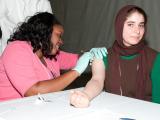Feb 22, 2008 (CIDRAP News) – Influenza activity was widespread in 49 US states by the end of last week, up from 44 states a week earlier, but the epidemic's growth was not as dramatic as it was the previous week, the Centers for Disease Control and Prevention (CDC) said today.
Nancy Cox, MD, chief of the CDC's influenza division, told reporters at a media teleconference today that Florida is the only state reporting only regional activity. "Flu activity has continued to increase, but not quite as dramatically as the increases we've seen over the previous 2 weeks," she said.
"From a 10-year perspective, we are within the normal parameters of what we'd expect for an influenza season," she said.
Cox said the predominant influenza subtype in the United States is still A/H3N2, though H1N1 subtypes were more common at the beginning of the season. Most of the H3N2 isolates the CDC has analyzed so far involve the A/Brisbane/10/2007-like variant, which does not match this season's vaccine. According to the most recent surveillance information, for the week ending Feb 16, 79% (55) of the H3N2 samples the CDC analyzed were the Brisbane variant.
Among the 69 influenza B samples the CDC has analyzed, 94% (64) were in the Yamagata lineage, which also is not included in this year's vaccine. In contrast, 88% (124 of 141) of H1N1 isolates analyzed so far matched the Solomon Islands strain used in the vaccine.
The number of pediatric deaths related to the flu rose to 22 last week, up 12 from the previous week's total, Cox reported.
Although only one of the three flu subtypes circulating this year is well matched by the vaccine, CDC officials say they haven't noted any unusual patterns of clinical consequences. Cox said the CDC often receives anecdotal reports of influenza in patients who have received the vaccine, even in years when the circulating viruses and the vaccine are well matched.
She said the CDC is conducting studies of the effectiveness of this year's vaccine and will publish the results in an upcoming issue of Morbidity and Mortality Weekly Report.
Physicians' impressions of flu season
Some physicians contacted by CIDRAP News this week stopped short of describing the flu season as worse than usual, despite the irregularities that have been reported with the vaccine and circulating strains.
William Schaffner, MD, chair of the Department of Preventive Medicine at the Vanderbilt University School of Medicine in Nashville, said flu has been increasing in Tennessee recently, but he expects the season to be no worse than average. Schaffner also is vice president of the National Foundation for Infectious Diseases.
"In the middle Tennessee area we're certainly seeing a lot of flu-like illness, and my sense is when the more specific diagnostic tests are being used, they're coming up positive," he said. "My sense is that we're going to have a moderate influenza season, not one that'll fill every bed in every hospital. But it's brisk—doctors and emergency rooms are getting lots of calls."
Noting that one flu strain in the vaccine (H1N1) matches well with viruses circulating in the United States, Schaffner said he was not worried about the imperfect match between the vaccine and viruses. "I'm not at all distressed that we have one bull's eye, one a little off the bull's eye, and one that misses the target completely. That's pretty good," he said.
"The major reason we give influenza vaccine is to prevent the complications of flu," Schaffner added. The vaccine may provide complete protection for young people with robust immune systems, he explained. In frail people, the vaccine often yields incomplete protection, but it may still prevent pneumonia, hospitalization, or worse, he said.
He added that mismatches between the vaccine and the viruses happen "with some frequency." Most of the time, "The issue is not whether there's a mismatch, but by how much. Analyses almost always indicate you have some protection."
Henry "Hank" Bernstein, DO, chief of general pediatrics at the Children's Hospital at Dartmouth, in Lebanon, N.H., said the flu season was quiet in his area until a few weeks ago. However, Bernstein, a member of the American Academy of Pediatrics' Committee on Infectious Diseases, said he has heard anecdotal reports from across the nation of vaccinated patients who were sick with flu.
"I emphasize that there are still vaccine doses available and that people should continue to get their immunizations until the spring," he said. "There are different peaks at different times throughout the season."
Priya Sampathkumar, MD, an infectious disease specialist at the Mayo Clinic in Rochester, Minn., said in an e-mail that she has seen influenza infections in vaccinated patients, but that the disease seems less severe in such instances.
Tamiflu resistance
European health officials have reported increasing rates of oseltamivir (Tamiflu) resistance in circulating influenza A/H1N1 viruses this season, and the CDC has also found a higher prevalence of resistant isolates than in previous years. In its most recent update, the CDC said it has tested 471 flu viruses and found that 27 (5.7%) had the oseltamivir resistance mutation, up slightly from the 4.6% reported a week ago. All were H1N1 viruses. In contrast, less than 1% of H1N1 viruses tested last year showed resistance.
Cox told reporters today that the CDC has received only sporadic reports of antiviral resistance from eight states. "We are increasing our surveillance for it, and we've solicited a lot of samples from state health departments," she said.
The Illinois Department of Public Health (IDPH) on Feb 14 issued an alert to healthcare providers about 10 Chicago-area patients that had antiviral-resistant flu infections; eight were from an outbreak at a single facility, which has not been named, according to a Feb 17 report from the Chicago Tribune.
The IDPH statement advised that influenza patients who are in intensive care should receive a combination of antiviral drugs until their viral samples are analyzed, the Tribune reported.
Schaffner said the reports of oseltamivir resistance are not affecting physicians' treatment decisions: "That's not playing a role at all in how physicians in this neck of the woods are using Tamiflu. Doctors are using it a lot. They're urging patients to come in early. Physicians have really gotten the message that you can shorten the duration and severity of influenza by treating [with antivirals]."
"I think it would be very difficult for those of us in practice to detect that [resistance] on a clinical level," he commented.
See also:
CDC's weekly flu overview
Feb 8 CIDRAP News story "CDC says influenza B strain doesn't match vaccine"
Feb 7 CIDRAP News story "Europe reports further increase in Tamiflu resistance"
Feb 6 CIDRAP News story "US seeing flu strain not matched by vaccine"



















